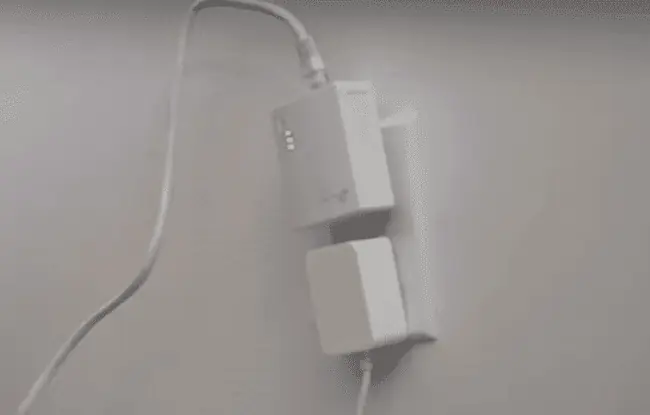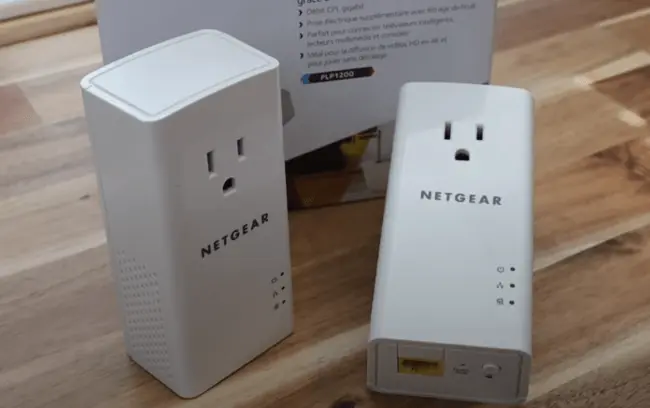A common question that gets asked on searches and forums is whether different makes and models of powerline adapters can be mixed and matched and still work together. There are all sorts of different brands with different speeds so is there a definitive way of finding out whether two different powerline adapters are compatible?
You should in theory be able to mix powerline adapters which meet HomePlug AV standards, since cross compatibility is required to be certified to that standard. However, in reality some users do have problems getting adapters of different brands or models to work together and performance is not guaranteed.
In general the newer and the closer the powerline adapters are in terms of brand/model/spec, the better the chance you have of getting them to work. However, it’s nowhere near guaranteed and you might need to experiment, persevere and in some cases accept that it won’t work between certain pairs of adapters, or that you’ll get reduced speeds as you older/slower adapters slow down the newer ones.
Lets look at the issue in more detail below.
The Theory On Powerline Cross Compatibility (HomePlug AV Standards)
Standards for powerline adapter compatibility are set by the HomePlug Alliance, which is like a voluntary industry body for the powerline adapter industry. It helps to set standards and provides guidance and support to the powerline adapter industry to improve the scope and standards of home connectivity solutions. Here is the mission statement from their own page:
HomePlug Alliance is a group of companies working together to develop technology specifications and certification & logo programs for powerline networking. HomePlug Alliance brings together the individual researchers, technologists, strategic thinkers, market experts, business decision-makers and product developers, and unites them in a common goal: to create a global environment where powerline communications can thrive.
One of the things they do is set standards for homeplugs or powerline adapters, and any plugs that meet the same HomePlug AV standards should in theory be cross compatible (the “in theory” is the important bit though that I’ll get to below). They started off in 2001 with the Homeplug 1.0 standard, moving on later to the Homeplug AV standard, the most common and relevant nowadays.
A new Homeplug AV2 standard is also being introduced, though this only applied to top of the range next gen gigabit powerline adapters.
The Practical Reality Of Cross Compatibility
Now we’ve covered the theory of how powerline adapters are supposed to work together, let’s be fair and cover the reality of whether they actually can work together across brands and models when people actually try it.
The bottom line is that some users have mixed different powerline adapters fine and not had any problems. In my own experience I’ve been fine mixing different adapters, but for me only different TP Link models. As regards mixing different brands, again there are some success stories:


And other users have run into problems and not go them to work:

Therefore, getting different powerline adapters to work together is kind of a lottery, with some luck involved in terms of the particular models you’ve got.
When they don’t work, it’s usually because different powerline adapter brands use different internal hardware and/or chipsets that prevent communication between models. But in some cases, there’s enough cross-over that they can can work together.
Here are some tips in this regard:
- For the best guarantee of performance, use the same model and brand when possible, since powerline performance can be temperamental even in best case scenarios.
- In rare cases, even having the exact same brand and model but different batches, can cause issues.
- If you’ve got loads of different brands/models already lying around, then it’s worth testing out mixing them. But you might need to be patient and keep experimenting, switching between different pairs until you get a set that work together.
- However, it’s not recommended to buy expensive powerline adapters on the assumption they’ll definitely work with different ones you already have.
- In general, the newer the models, the better the chance of cross compatibility. Older models are harder to mix and match.
- Look for “Homeplug AV2” on the adapters or packaging, or “AV500”, “AV600” or “AV1000” adapters for the best chance of cross compatibility.
- Using slower adapters with faster ones will slow down the speed of the entire network.
Cross Compatibility is Possible But Not Guaranteed
Intra brand compatibility of modern AV adapters is especially higher nowadays, in other words, different models of the same brand can work together. However, compatibility across brands is still not uncommon, but it varies between cases.
If you do have a compatible pair the only issue to consider is that, as with any network, the speed of powerline networks is determined by it’s weakest link. In other words, if you have two powerline adapters of different speeds, then they will often work together but only at the lowest speed. So if you have an AV200 adapter and an AV500 adapter, then the best speed you can hope to get is 200 mbps, that of the slowest adapter.
Another issue to watch out for is older powerline adapters, that are still on the older Homeplug 1.0 standard. These were the first powerline adapters, introduced in the early 2000s, and their maximum transfer speeds was only around 85 mbps, whereas modern models come with an absolute minimum speed of 200 mbps and usually 500 mbps transfer rate.
The Homeplug 1.0 powerline adapters are obsolete now and will not work with never AV/AV2 models, but they very rare, so if you are trying to mix and match really old powerline adapters from more than a decade ago then you may have issues getting them to work. Entry level modern AV certified adapters are really cheap now if you need a newer model; see our page on powerline adapters for more information.

Cross compatibility of powerline adapter models makes it easy to add new adapters and new devices to a home powerline network
Modern TP Link Products are Universally Cross Compatible
Whilst cross compatibility inside and between all major brands is very good nowadays, TP Link are exceptional on this in that pretty much all of their product range has universal cross compatibility, over both the wired and wireless powerline adapter range. So all their models will work equally well with each other, though as we said network speeds will be determined by the slowest adapter.
This is great, as it allows for easy expansion of home powerline networks as bandwidth needs grow for gaming, streaming and downloading. New models can easily be added to the network even if they are different from the existing models on the network and the adapters will still communicate
For example, if someone starts out with a pair of wired powerline adapters like the TP Link TL-PA4016P Kit from Amazon for gaming in one room, but then at a later date someone else wants to have another adapter in their own room for streaming but also to connect Wi-Fi devices, then they can get a more advanced model that has Wi-Fi booster functions on it like the TL-WPA-4220 Kit and the two models will work together.
See TP Link’s help page for adding more powerline adapters to a home network.
